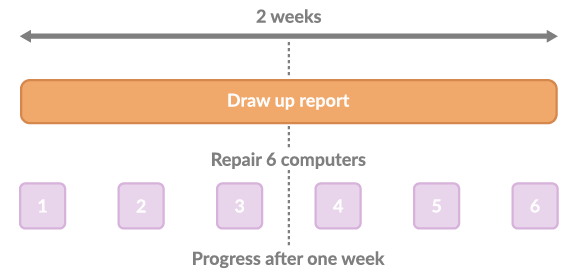Clear and concrete communication of project progress
Research shows that almost half of all projects go over the end date and exceed the budget, despite the fact that project managers have progress information. Now it appears that project progress reports are often inaccurate. This creates the risk that the project manager takes the wrong decision and therefore cannot manage the project properly in time.
In this blog we discuss the three preconditions for a good project progress report. First, we look for the right project subdivision. Then, we look at how the progress measurement can best be set up. Finally, we look at how important it is that you develop a good discipline to constantly report the progress of activities.
1. A correct project subdivision
The first precondition for a good project progress report is a good subdivision of your project. We discuss the various options in detail in the blog “Chopping up your project planning” We also give tips there when you can best use which method.

If you want to report progress within your project, we recommend that you divide your project into interim results. You can describe intermediate results in concrete terms. For example: Giving software training to department A or placing five desks in department B. These results are very specific and you can determine the progress of this well. This is less easy to do if you split a project into activities. The progress of the “software training” activity, for example, is more difficult to indicate if you have to train a total of 1,000 employees from different departments where the training differs per department.
When setting up a project, a clear subdivision into intermediate results is often omitted. The result is that the reporting of progress takes place on a global level and based on feeling. This can lead to an incorrect project progress report.
2. An appropriate method of measuring progress
The second precondition for a good project progress report is the appropriate measurement of project progress. Many people determine this with the help of a “percentage achieved”. It is often thought that this is the only method to measure progress, but it can also be done in a different way. Not every situation is best captured with a percentage achieved. You can also ask yourself how you should apply the percentage.
We explain this based on an example. The project progress of the following two activities is determined:
- Preparation of a report
- Repair of six computers

When the progress of the activity is reported, the report appears to be halfway through and three computers have been repaired. Does this mean that the progress of both activities is fifty percent?
For the repair of the computers you can certainly say this. It is not necessarily more convenient for the employee to work with a percentage achieved here. It is easier for him or her to report that 3 computers have been repaired. Ultimately we can of course translate it into a percentage, because 3 of the 6 computers have been repaired = 50% achieved.
In the project progress reporting of the report you can wonder if it is 50% ready. When reporting progress, it is usually about getting an impression of the realized value and not about the effort made. A half report has no value in that respect.
This example shows that you can make a choice as to how you can determine the progress and whether you assess it according to realized value or not. The latter aspect in particular can make a considerable difference in reporting. A difference of 0 and 100%.
3. Constantly keeping track of project progress
The third precondition is the constant monitoring of progress. When planning projects discipline is often lacking in this area. The result is that you lack information with which you as project manager can adjust the project and the planning thoroughly and on time. Project planning is often outdated at the start of a project, because the environment of a project is constantly changing.
To properly perform the analysis of the project progress, you must first ascertain the method of reporting. Who will report the project progress? This depends on the format of the project. Large projects require a different approach than a small one. How often do people have to report the project progress? This determines how current the project information is that a project manager has. In addition to these two points, you also have to take into account the psychological effect on employees that the reporting of progress causes. In the blog: “How do you organize the reporting of project progress?” we discuss the three points in detail.
If you have set up thorough project progress reporting, the project manager will receive a continuous and current stream of planning information. This way, a project manager can easily identify deviations in project performance, analyze causes and take measures on time. This makes it a lot easier to ensure that the project is completed on time and within budget.
Conclusion
You can invest a lot of time and effort in reporting progress and analyzing it. If you do not take into account the three preconditions that apply to a good project progress report, then it has often been a waste of time. You will in all likelihood make decisions based on inaccurate information with all its consequences.
If you want to prevent this, divide your project first. Do this on interim results. Then determine for each interim result how you will determine progress. Based on realized numbers or with a percentage achieved? And in the case of a percentage achieved, will you measure on the basis of realized value or effort made? By answering this, you meet the second precondition for a good project progress report. The third and final precondition is the continuous reporting of progress. With a continuous stream of progress information, your project manager stays in control of his or her projects. Deviations from projects are noticed in time and the project manager has reliable and up-to-date information that he or she can actually use.





